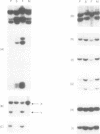Abstract
We report on a sex reversed Japanese child with a 46,X,Yp+ karyotype, minor dysmorphic features, and no testicular development. The Yp+ chromosome was derived by translocation of an Xp fragment (Xp21-Xp22.3) to Yp11.3. This has resulted in deletion of distal part of the Y chromosome pseudoautosomal region (DXYS15-telomere) and duplication of the X specific region (DXS84-PABX) and proximal part of the pseudoautosomal region (MIC2-DXYS17). No deletion of the Y specific region was detected nor was any mutation found in SRY. Cytogenetic analysis suggests that the proximal part of the Xp fragment is the most distal part of the short arm of the Yp+ chromosome (Xp21----Xp 22.3::Yp11.3----Yqter). No chromosomal mosaicism was detected. These results are similar to previous reports of sex reversal in four subjects with a 46,Y,Xp+ karyotype. We conclude that the sex reversal is a direct, or indirect, consequence of having two active copies of the distal part of Xp and may indicate the presence of a gene(s) which acts in the testis determination or differentiation pathway.
Full text
PDF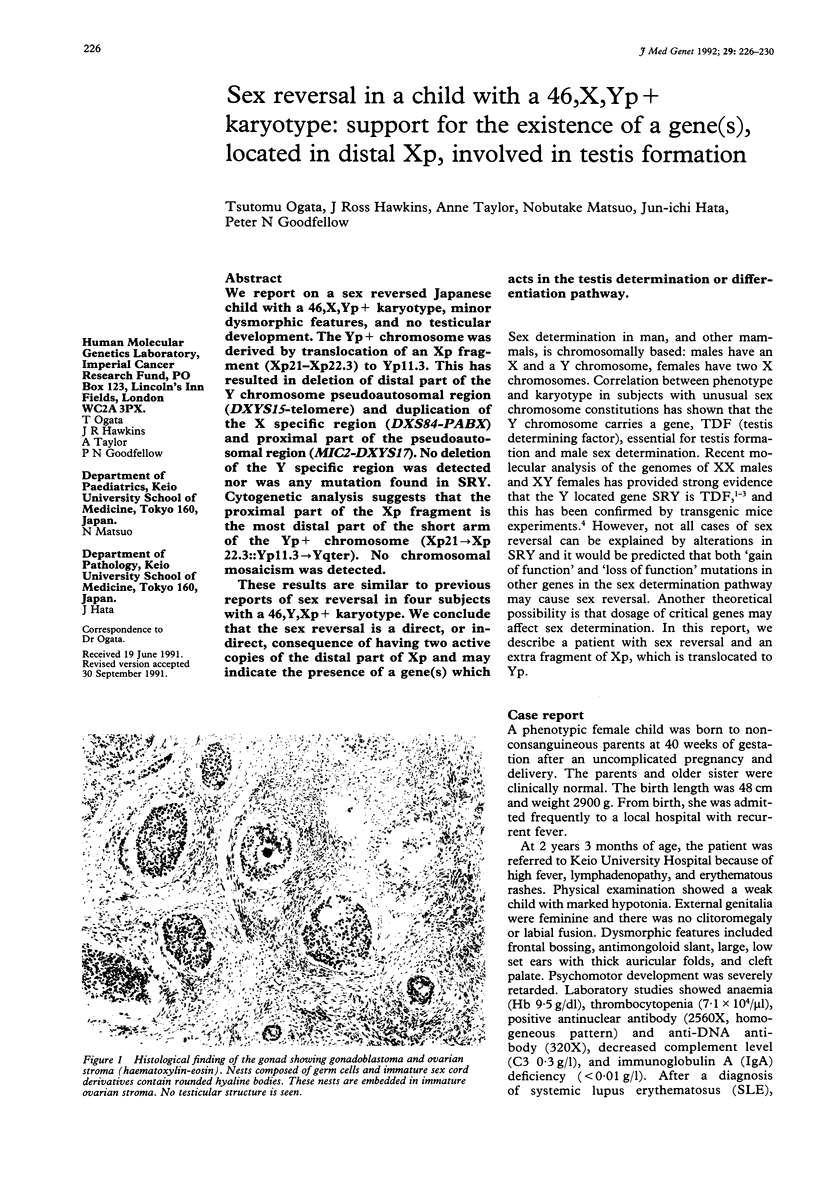
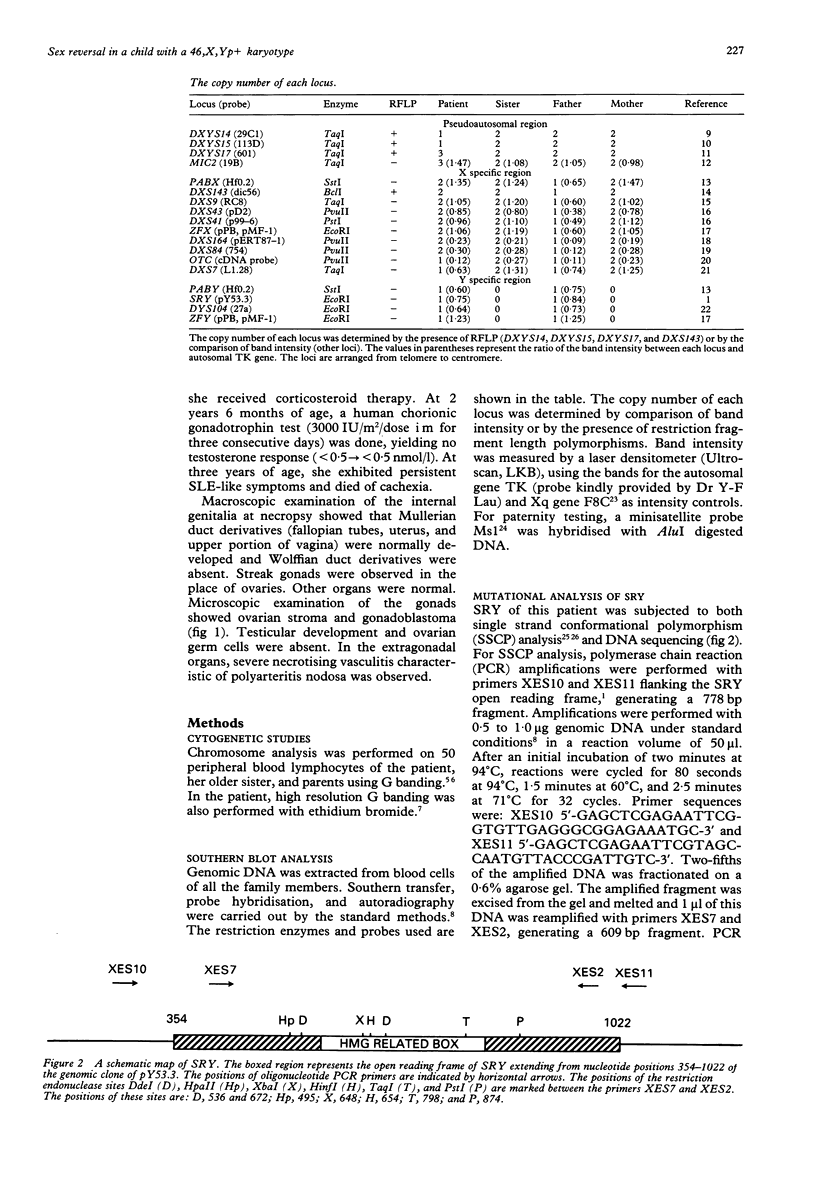
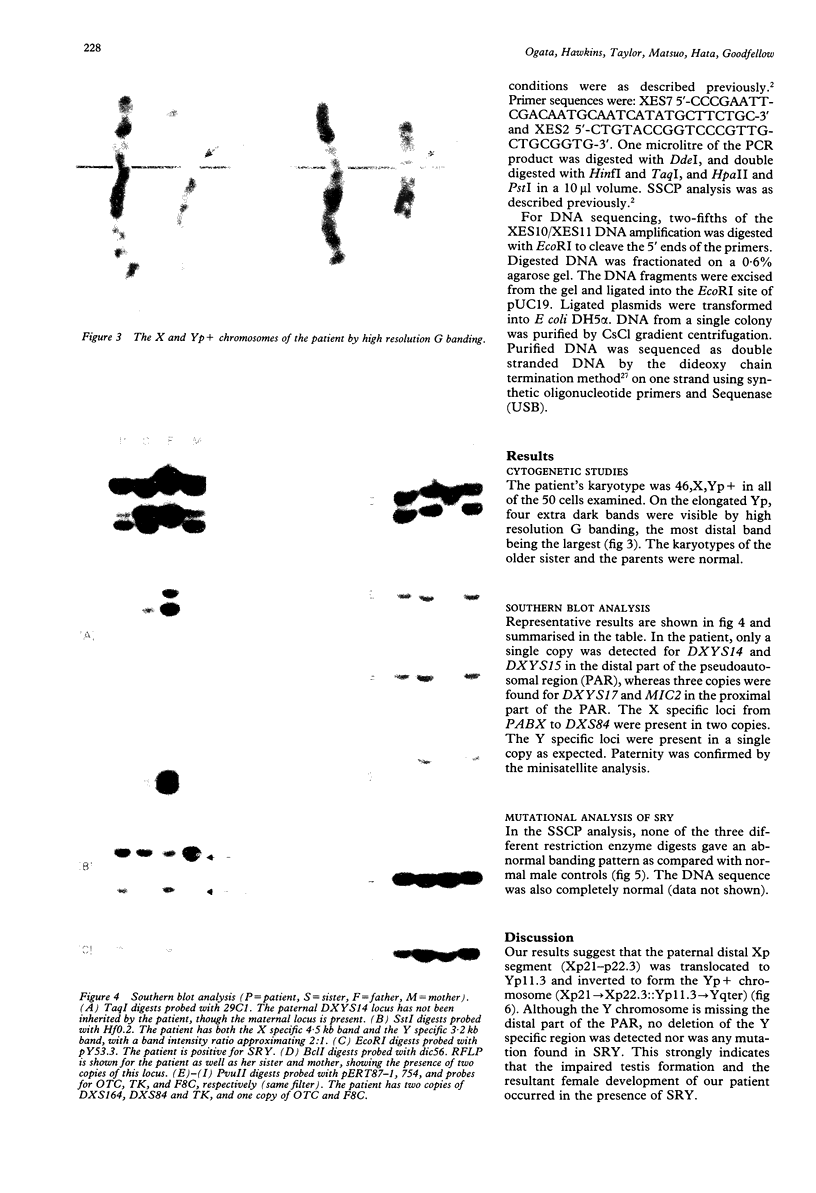
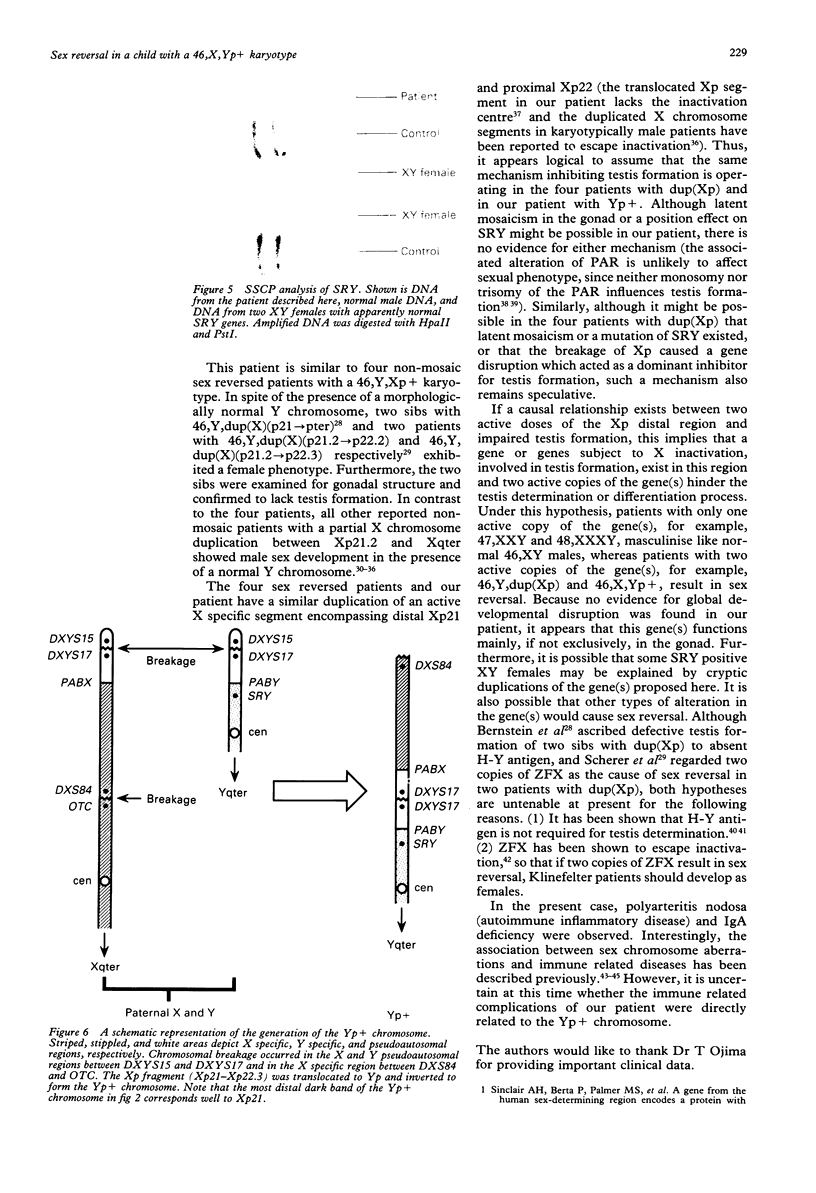
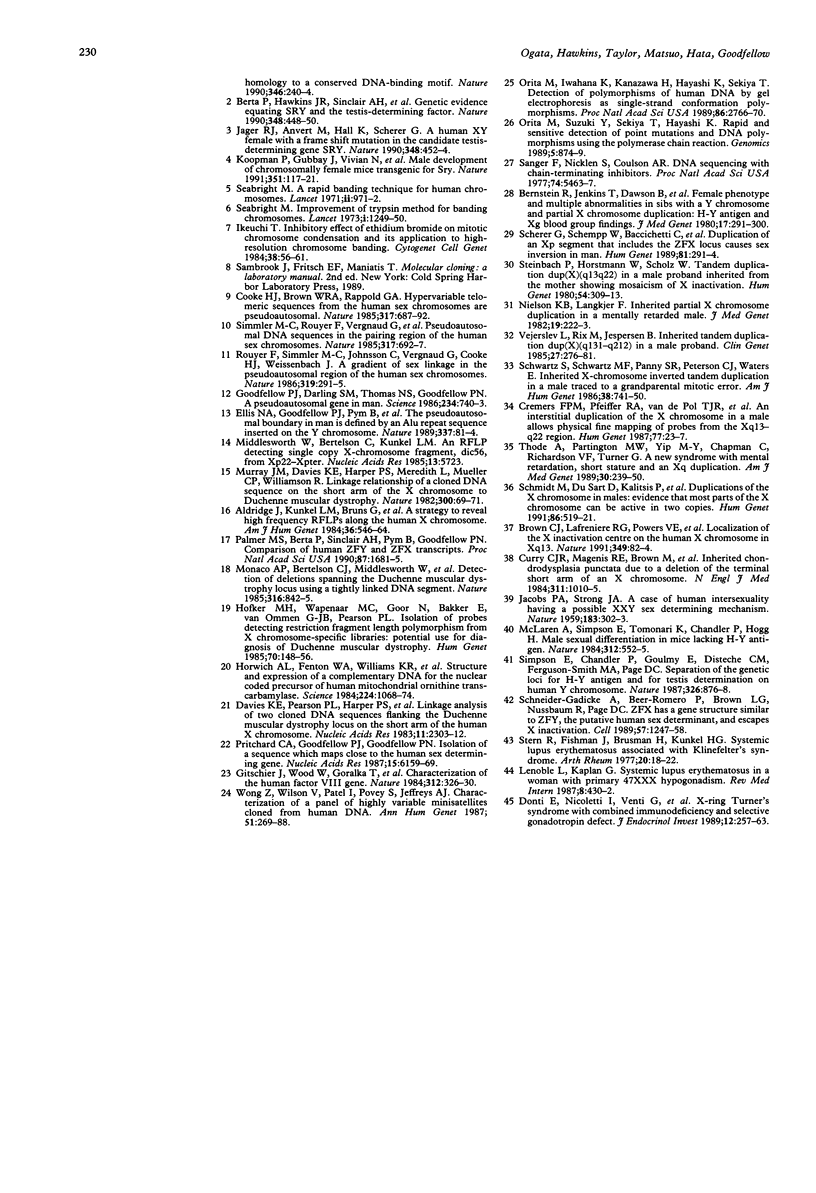
Images in this article
Selected References
These references are in PubMed. This may not be the complete list of references from this article.
- Aldridge J., Kunkel L., Bruns G., Tantravahi U., Lalande M., Brewster T., Moreau E., Wilson M., Bromley W., Roderick T. A strategy to reveal high-frequency RFLPs along the human X chromosome. Am J Hum Genet. 1984 May;36(3):546–564. [PMC free article] [PubMed] [Google Scholar]
- Bernstein R., Jenkins T., Dawson B., Wagner J., Dewald G., Koo G. C., Wachtel S. S. Female phenotype and multiple abnormalities in sibs with a Y chromosome and partial X chromosome duplication: H--Y antigen and Xg blood group findings. J Med Genet. 1980 Aug;17(4):291–300. doi: 10.1136/jmg.17.4.291. [DOI] [PMC free article] [PubMed] [Google Scholar]
- Berta P., Hawkins J. R., Sinclair A. H., Taylor A., Griffiths B. L., Goodfellow P. N., Fellous M. Genetic evidence equating SRY and the testis-determining factor. Nature. 1990 Nov 29;348(6300):448–450. doi: 10.1038/348448A0. [DOI] [PubMed] [Google Scholar]
- Brown C. J., Lafreniere R. G., Powers V. E., Sebastio G., Ballabio A., Pettigrew A. L., Ledbetter D. H., Levy E., Craig I. W., Willard H. F. Localization of the X inactivation centre on the human X chromosome in Xq13. Nature. 1991 Jan 3;349(6304):82–84. doi: 10.1038/349082a0. [DOI] [PubMed] [Google Scholar]
- Cooke H. J., Brown W. R., Rappold G. A. Hypervariable telomeric sequences from the human sex chromosomes are pseudoautosomal. Nature. 1985 Oct 24;317(6039):687–692. doi: 10.1038/317687a0. [DOI] [PubMed] [Google Scholar]
- Cremers F. P., Pfeiffer R. A., van de Pol T. J., Hofker M. H., Kruse T. A., Wieringa B., Ropers H. H. An interstitial duplication of the X chromosome in a male allows physical fine mapping of probes from the Xq13-q22 region. Hum Genet. 1987 Sep;77(1):23–27. doi: 10.1007/BF00284707. [DOI] [PubMed] [Google Scholar]
- Curry C. J., Magenis R. E., Brown M., Lanman J. T., Jr, Tsai J., O'Lague P., Goodfellow P., Mohandas T., Bergner E. A., Shapiro L. J. Inherited chondrodysplasia punctata due to a deletion of the terminal short arm of an X chromosome. N Engl J Med. 1984 Oct 18;311(16):1010–1015. doi: 10.1056/NEJM198410183111603. [DOI] [PubMed] [Google Scholar]
- Davies K. E., Pearson P. L., Harper P. S., Murray J. M., O'Brien T., Sarfarazi M., Williamson R. Linkage analysis of two cloned DNA sequences flanking the Duchenne muscular dystrophy locus on the short arm of the human X chromosome. Nucleic Acids Res. 1983 Apr 25;11(8):2303–2312. doi: 10.1093/nar/11.8.2303. [DOI] [PMC free article] [PubMed] [Google Scholar]
- Donti E., Nicoletti I., Venti G., Filipponi P., Gerli R., Spinozzi F., Cernetti C., Rambotti P. X-ring Turner's syndrome with combined immunodeficiency and selective gonadotropin defect. J Endocrinol Invest. 1989 Apr;12(4):257–263. doi: 10.1007/BF03349979. [DOI] [PubMed] [Google Scholar]
- Ellis N. A., Goodfellow P. J., Pym B., Smith M., Palmer M., Frischauf A. M., Goodfellow P. N. The pseudoautosomal boundary in man is defined by an Alu repeat sequence inserted on the Y chromosome. Nature. 1989 Jan 5;337(6202):81–84. doi: 10.1038/337081a0. [DOI] [PubMed] [Google Scholar]
- Facing up to the Chernobyl accident. Nature. 1991 May 2;351(6321):1–1. doi: 10.1038/351001a0. [DOI] [PubMed] [Google Scholar]
- Gitschier J., Wood W. I., Goralka T. M., Wion K. L., Chen E. Y., Eaton D. H., Vehar G. A., Capon D. J., Lawn R. M. Characterization of the human factor VIII gene. Nature. 1984 Nov 22;312(5992):326–330. doi: 10.1038/312326a0. [DOI] [PubMed] [Google Scholar]
- Goodfellow P. J., Darling S. M., Thomas N. S., Goodfellow P. N. A pseudoautosomal gene in man. Science. 1986 Nov 7;234(4777):740–743. doi: 10.1126/science.2877492. [DOI] [PubMed] [Google Scholar]
- Hofker M. H., Wapenaar M. C., Goor N., Bakker E., van Ommen G. J., Pearson P. L. Isolation of probes detecting restriction fragment length polymorphisms from X chromosome-specific libraries: potential use for diagnosis of Duchenne muscular dystrophy. Hum Genet. 1985;70(2):148–156. doi: 10.1007/BF00273073. [DOI] [PubMed] [Google Scholar]
- Horwich A. L., Fenton W. A., Williams K. R., Kalousek F., Kraus J. P., Doolittle R. F., Konigsberg W., Rosenberg L. E. Structure and expression of a complementary DNA for the nuclear coded precursor of human mitochondrial ornithine transcarbamylase. Science. 1984 Jun 8;224(4653):1068–1074. doi: 10.1126/science.6372096. [DOI] [PubMed] [Google Scholar]
- Ikeuchi T. Inhibitory effect of ethidium bromide on mitotic chromosome condensation and its application to high-resolution chromosome banding. Cytogenet Cell Genet. 1984;38(1):56–61. doi: 10.1159/000132030. [DOI] [PubMed] [Google Scholar]
- JACOBS P. A., STRONG J. A. A case of human intersexuality having a possible XXY sex-determining mechanism. Nature. 1959 Jan 31;183(4657):302–303. doi: 10.1038/183302a0. [DOI] [PubMed] [Google Scholar]
- Jäger R. J., Anvret M., Hall K., Scherer G. A human XY female with a frame shift mutation in the candidate testis-determining gene SRY. Nature. 1990 Nov 29;348(6300):452–454. doi: 10.1038/348452a0. [DOI] [PubMed] [Google Scholar]
- Lenoble L., Kaplan G. Lupus érythémateux disséminé chez une femme atteinte d'un hypogonadisme primaire 47XXX. Rev Med Interne. 1987 Sep-Oct;8(4):430–432. doi: 10.1016/s0248-8663(87)80020-6. [DOI] [PubMed] [Google Scholar]
- McLaren A., Simpson E., Tomonari K., Chandler P., Hogg H. Male sexual differentiation in mice lacking H-Y antigen. Nature. 1984 Dec 6;312(5994):552–555. doi: 10.1038/312552a0. [DOI] [PubMed] [Google Scholar]
- Middlesworth W., Bertelson C., Kunkel L. M. An RFLP detecting single copy X-chromosome fragment, dic56, from Xp22-Xpter [HGM8 assignment no. DXS 143]. Nucleic Acids Res. 1985 Aug 12;13(15):5723–5723. doi: 10.1093/nar/13.15.5723. [DOI] [PMC free article] [PubMed] [Google Scholar]
- Monaco A. P., Bertelson C. J., Middlesworth W., Colletti C. A., Aldridge J., Fischbeck K. H., Bartlett R., Pericak-Vance M. A., Roses A. D., Kunkel L. M. Detection of deletions spanning the Duchenne muscular dystrophy locus using a tightly linked DNA segment. 1985 Aug 29-Sep 4Nature. 316(6031):842–845. doi: 10.1038/316842a0. [DOI] [PubMed] [Google Scholar]
- Murray J. M., Davies K. E., Harper P. S., Meredith L., Mueller C. R., Williamson R. Linkage relationship of a cloned DNA sequence on the short arm of the X chromosome to Duchenne muscular dystrophy. Nature. 1982 Nov 4;300(5887):69–71. doi: 10.1038/300069a0. [DOI] [PubMed] [Google Scholar]
- Nielsen K. B., Langkjaer F. Inherited partial X chromosome duplication in a mentally retarded male. J Med Genet. 1982 Jun;19(3):222–224. doi: 10.1136/jmg.19.3.222. [DOI] [PMC free article] [PubMed] [Google Scholar]
- Orita M., Iwahana H., Kanazawa H., Hayashi K., Sekiya T. Detection of polymorphisms of human DNA by gel electrophoresis as single-strand conformation polymorphisms. Proc Natl Acad Sci U S A. 1989 Apr;86(8):2766–2770. doi: 10.1073/pnas.86.8.2766. [DOI] [PMC free article] [PubMed] [Google Scholar]
- Orita M., Suzuki Y., Sekiya T., Hayashi K. Rapid and sensitive detection of point mutations and DNA polymorphisms using the polymerase chain reaction. Genomics. 1989 Nov;5(4):874–879. doi: 10.1016/0888-7543(89)90129-8. [DOI] [PubMed] [Google Scholar]
- Palmer M. S., Berta P., Sinclair A. H., Pym B., Goodfellow P. N. Comparison of human ZFY and ZFX transcripts. Proc Natl Acad Sci U S A. 1990 Mar;87(5):1681–1685. doi: 10.1073/pnas.87.5.1681. [DOI] [PMC free article] [PubMed] [Google Scholar]
- Pritchard C. A., Goodfellow P. J., Goodfellow P. N. Isolation of a sequence which maps close to the human sex determining gene. Nucleic Acids Res. 1987 Aug 11;15(15):6159–6169. doi: 10.1093/nar/15.15.6159. [DOI] [PMC free article] [PubMed] [Google Scholar]
- Rouyer F., Simmler M. C., Johnsson C., Vergnaud G., Cooke H. J., Weissenbach J. A gradient of sex linkage in the pseudoautosomal region of the human sex chromosomes. Nature. 1986 Jan 23;319(6051):291–295. doi: 10.1038/319291a0. [DOI] [PubMed] [Google Scholar]
- Sanger F., Nicklen S., Coulson A. R. DNA sequencing with chain-terminating inhibitors. Proc Natl Acad Sci U S A. 1977 Dec;74(12):5463–5467. doi: 10.1073/pnas.74.12.5463. [DOI] [PMC free article] [PubMed] [Google Scholar]
- Scherer G., Schempp W., Baccichetti C., Lenzini E., Bricarelli F. D., Carbone L. D., Wolf U. Duplication of an Xp segment that includes the ZFX locus causes sex inversion in man. Hum Genet. 1989 Feb;81(3):291–294. doi: 10.1007/BF00279008. [DOI] [PubMed] [Google Scholar]
- Schmidt M., Du Sart D., Kalitsis P., Leversha M., Dale S., Sheffield L., Toniolo D. Duplications of the X chromosome in males: evidence that most parts of the X chromosome can be active in two copies. Hum Genet. 1991 Mar;86(5):519–521. doi: 10.1007/BF00194646. [DOI] [PubMed] [Google Scholar]
- Schneider-Gädicke A., Beer-Romero P., Brown L. G., Nussbaum R., Page D. C. ZFX has a gene structure similar to ZFY, the putative human sex determinant, and escapes X inactivation. Cell. 1989 Jun 30;57(7):1247–1258. doi: 10.1016/0092-8674(89)90061-5. [DOI] [PubMed] [Google Scholar]
- Schwartz S., Schwartz M. F., Panny S. R., Peterson C. J., Waters E., Cohen M. M. Inherited X-chromosome inverted tandem duplication in a male traced to a grandparental mitotic error. Am J Hum Genet. 1986 May;38(5):741–750. [PMC free article] [PubMed] [Google Scholar]
- Seabright M. A rapid banding technique for human chromosomes. Lancet. 1971 Oct 30;2(7731):971–972. doi: 10.1016/s0140-6736(71)90287-x. [DOI] [PubMed] [Google Scholar]
- Seabright M. Improvement of trypsin method for banding chromosomes. Lancet. 1973 Jun 2;1(7814):1249–1250. doi: 10.1016/s0140-6736(73)90561-8. [DOI] [PubMed] [Google Scholar]
- Simmler M. C., Rouyer F., Vergnaud G., Nyström-Lahti M., Ngo K. Y., de la Chapelle A., Weissenbach J. Pseudoautosomal DNA sequences in the pairing region of the human sex chromosomes. Nature. 1985 Oct 24;317(6039):692–697. doi: 10.1038/317692a0. [DOI] [PubMed] [Google Scholar]
- Simpson E., Chandler P., Goulmy E., Disteche C. M., Ferguson-Smith M. A., Page D. C. Separation of the genetic loci for the H-Y antigen and for testis determination on human Y chromosome. 1987 Apr 30-May 6Nature. 326(6116):876–878. doi: 10.1038/326876a0. [DOI] [PubMed] [Google Scholar]
- Sinclair A. H., Berta P., Palmer M. S., Hawkins J. R., Griffiths B. L., Smith M. J., Foster J. W., Frischauf A. M., Lovell-Badge R., Goodfellow P. N. A gene from the human sex-determining region encodes a protein with homology to a conserved DNA-binding motif. Nature. 1990 Jul 19;346(6281):240–244. doi: 10.1038/346240a0. [DOI] [PubMed] [Google Scholar]
- Steinbach P., Horstmann W., Scholz W. Tandem duplication dup(X)(q13q22) in a male proband inherited from the mother showing mosaicism of X-inactivation. Hum Genet. 1980;54(3):309–313. doi: 10.1007/BF00291574. [DOI] [PubMed] [Google Scholar]
- Stern R., Fishman J., Brusman H., Kunkel H. G. Systemic lupus erythematosus associated with klinefelter's syndrome. Arthritis Rheum. 1977 Jan-Feb;20(1):18–22. doi: 10.1002/art.1780200103. [DOI] [PubMed] [Google Scholar]
- Thode A., Partington M. W., Yip M. Y., Chapman C., Richardson V. F., Turner G. A new syndrome with mental retardation, short stature and an Xq duplication. Am J Med Genet. 1988 May-Jun;30(1-2):239–250. doi: 10.1002/ajmg.1320300125. [DOI] [PubMed] [Google Scholar]
- Vejerslev L. O., Rix M., Jespersen B. Inherited tandem duplication dup(X) (q131-q212) in a male proband. Clin Genet. 1985 Mar;27(3):276–281. doi: 10.1111/j.1399-0004.1985.tb00220.x. [DOI] [PubMed] [Google Scholar]
- Wong Z., Wilson V., Patel I., Povey S., Jeffreys A. J. Characterization of a panel of highly variable minisatellites cloned from human DNA. Ann Hum Genet. 1987 Oct;51(Pt 4):269–288. doi: 10.1111/j.1469-1809.1987.tb01062.x. [DOI] [PubMed] [Google Scholar]





